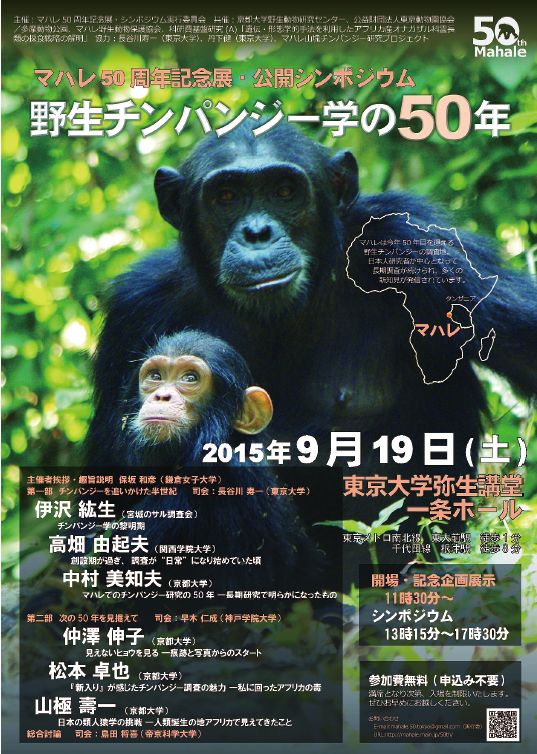|
<NEWS>
Mahale Research 50th Anniversary
Kazuhiko Hosaka
Co-chairman, Mahale Wildlife Conservation Society, c/o Kamakura Women’s University, Japan A half century has passed since Junichiro Itani and his students met in September 1965 at the Kasakati Basin and decided to embark on a challenge of habituating wild chimpanzees of the Mahale Mountains (Itani 1970). Mahale had been a prospective candidate site for a longterm chimpanzee research since Itani went on his first expedition to Tanganyika in 1960 with Kinji Imanishi, his predecessor as the project leader (Itani 1961). However, it took the research team 4 years to reach Mahale until Kosei Izawa finally visited Kasoje just before the meeting (Izawa 1977). The initial priority of the team was to habituate chimpanzees living in savannah–woodland areas to the northeast of Mahale because researchers aimed to look for clues to understand how human ancestors shifted their habitats from forested to arid ones (Itani 1970). Toshisada Nishida successfully habituated chimpanzees by artificial provisioning in July 1966, which was the start of the second longest-running chimpanzee research project. The food given to chimpanzees was later reduced and observational studies have been conducted without provisioning since 1987. The project was joined by many researchers including Kenji Kawanaka and Shigeo Uehara, and it has produced numerous scientific findings concerning the behaviour, ecology, and society of Mahale chimpanzees, although there is not enough space here to go into details. In 1985, Mahale became the 11th national park of Tanzania, representing triumph for researchers who had dedicated two decades to research wildlife, especially chimpanzees, and to protect them from deforestation and other threats to survival. However, at the same time, the birth of the Mahale Mountains National Park presented dramatic societal and lifestyle changes for the Watongwe, indigenous people of Mahale. The Mahale Wildlife Conservation Society, established in 1994, has contributed to improvements in education and medical services of the local community. We believe that spontaneous involvement of the Watongwe people is crucial for environmental conservation because their ethnicity and traditional knowledge are closely connected to nature in and around Mahale. Recently, the research team has broadened its focus beyond chimpanzees, partly as an inevitable response to modern-day demands to conserve ‘biodiversity.’ Leopard research has been initiated recently, whereas an interest in diurnal and nocturnal mammals that share habitats with chimpanzees is ongoing. In addition, some researchers, including Gen’ichi Idani and Hideshi Ogawa are continuing an extensive study regarding savannah-dwelling chimpanzees in Ugalla; this project was resumed in 1994 by Takayoshi Kano, who participated in a pioneer study there with Itani in 1966. A collaborative research project to study wildlife in ‘Greater Mahale’—covering a wide area including Mahale and Ugalla—is also ongoing for an integrative understanding of regional biodiversity, which is essential in terms of conservation strategies. 
Figure 1. The poster for a public outreach event that will take place at the Yayoi Auditorium, University of Tokyo on 19 September 2015. To commemorate the 50th anniversary of the Mahale Mountains Chimpanzee Research Project, various events will be held beginning this July. First, the workshop ‘Fifty years of research on wild chimpanzees: Significance and future of long-term research’ will be offered at the 31st Congress of the Primate Society of Japan in Kyoto on 18 July. Second, ‘Mahale 50: Exhibition and symposium’ will be held as a public outreach event in Tokyo on 19 September (Figure 1). Two new books edited by Mahale researchers are expected to be released during this event: one is a thick academic volume (in English) by many researchers who have studied Mahale chimpanzees (announced in this issue for details), and the other—written in Japanese by Nakamura for general readers—provides the history of Mahale chimpanzee research. Third, the symposium ‘A half-century of wild chimpanzee research: How does long-term wild ape research contribute to anthropology?’ will be held in Tokyo at the 69th Congress of the Anthropological Society of Nippon on 12 October. Finally, the ceremony to celebrate the 50th anniversary of international collaboration at Mahale is being planned to take place at Kigoma, Tanzania—perhaps in November. The next issue of Pan Africa News will include reviews of some of these events. REFERENCES Itani J 1961. [The Forest of Gorillas and Pigmies.] Iwanamishoten, Tokyo, in Japanese. Itani J 1970. [In the Pursuit of Chimpanzees.] Chikumashobo, Tokyo, in Japanese. Izawa K 1977. [The chimpanzees of the Kasakati Basin, II.] In: [The Chimpanzees.] Itani J (ed). Kōdansha, Tokyo, pp. 187–248, in Japanese. Back to Contents |